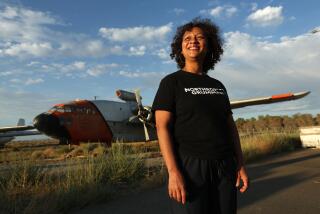Online Class at O.C. College Offers Lesson About Future
- Share via
His classroom is his living room.
He can drink beer during lectures.
And best of all, when he’s tired of the day’s lesson--which he endures whenever he wants--he simply clicks his computer mouse and goes surfing. Web surfing, that is.
For Dave Sanders and the 16 other students taking Saddleback College’s “Introduction to Oceanography” on the World Wide Web, homework assignments, lectures, quizzes and other course materials exist in a cyber-classroom accessible at their fingertips, 24 hours per day, with a few taps on the computer keyboard.
The computer may crash; the Internet server may go down. They still must contend with ocean chemistry and deep-water biology and the other mysteries of oceanography bedeviling the nearly 200 other students taking the course the old-fashioned way on campus.
But, as Sanders put it, “I can drink beer at 2 a.m. in my underwear and slap in any CD I want while I take this class. You can’t beat that.”
With the tide heavy toward developing “virtual classrooms” and “virtual universities”--by the end of the year a consortium of Western governors plans to launch a university entirely in cyberspace and California officials are contemplating the same--Saddleback’s class offers lessons for the future.
“It’s trite to say we are on the cutting edge,” says Joe Valencic, who along with fellow professor Anthony Huntley created and teaches the class, one of the few regular, for-credit online courses in the state. “But we really are.”
Experts agree, though some aren’t ready to declare chalk obsolete.
“Online education is one of the most important tools higher education will have in the next decade to help solve its problems,” said David McArthur, an analyst at RAND Corp, referring to a predicted enrollment surge at California institutions in the next few years. “Schools will need to be able to educate many more people than they now can, and less expensively.”
“Right now, most online courses aren’t that good,” he added. “But they are improving quickly, and they’ll be needed badly.”
Already, more than 1,000 courses nationwide--nobody is really sure how many--are offered online, ranging from correspondence courses that simply have moved from the mailbox to the Net to a smattering of full-fledged master’s degree programs presented by accredited institutions.
And more are on the way, says Carol Twigg of Educom, a Washington, D.C.-based consortium of 600 leading universities and high-tech companies seeking ways to integrate computers into instruction. “It’s hard to imagine a college or university not thinking about putting a course online or doing so already,” Twigg said.
The Western Assn. of Colleges and Schools, the region’s main accrediting commission, has left it up to individual campuses to decide if computerized versions of their regular courses will be offered for credit, a spokesman said.
The commission has not accredited any online undergraduate degree programs, although some individual courses are accredited, and only four graduate degree programs. All four are master’s programs related to computing and business, including one at Cal State Dominguez Hills in quality assurance, that have met demand from corporations and professionals to squeeze in learning while they work.
In higher education’s rush to the Web, debate has emerged as to whether this form of learning matches the quality of the lecture hall. Last year, the nation’s largest faculty association issued a stern cautionary note about replacing face-to-face instruction with computers.
But Huntley and Valencic maintain that the online class is as good as the one on campus, and hope their course shows the way for others.
Their class is taught almost entirely over the Web--save for a one-hour weekly lab session that involves hands-on practice with microscopes, test tubes and other tools.
Students tap into the class Web site--accessible only by password for security reasons--where they find homework assignments, lectures and other course materials.
They answer student queries by e-mail--and an occasional “cyber forum” where everybody signs on for an exchange of comments and questions--and offer quizzes with an automatic grading system that spits out results instantaneously.
To ensure that Web students have indeed completed and understand the work, they take the same final, on campus, as those in the on-campus classroom section.
Seven students completed the class last year, and the grade spread was typical of the lecture class, Huntley said.
This semester, the students’ work so far has matched the quality of their lecture room peers, Valencic said.
Cal State Northridge professor Jerald Schutte recently found that students randomly assigned to take his extension course on social statistics by computer performed 20% better on exams and other course work than their peers in the classroom. He attributed the results in part to the cyber-students’ forming online peer groups that enhanced their studying.
Those who teach online also say the use of e-mail sharpens students’ writing skills and allows for more thoughtful responses to problems.
Kathleen Lant, who teaches a regular, for-credit American literature course over the Web at Cal Poly San Luis Obispo, recalled one student from Vietnam who wrote a lengthy, eloquent missive comparing his country’s mind-set after the Vietnam War to that of America at the close of the Civil War.
“In a classroom discussion where things go so fast I had never heard that before. I was so moved.
“Some things happen better online.”
Students in Saddleback’s class by and large say it educates them as well as the classroom version, while honing their computing and research skills.
“I am in wonder and awe that I am able to participate in such a class,” said Sanders, who juggles his studies with part-time work at a bookstore. “I’ve been working on computers since I was 11 and was wondering when, if ever, I would be able to use the computer for something more practical than just typing papers or balancing my checkbook.”
Carol Roth, 41, a Laguna Niguel office worker, took the course in part to hone her computer skills, and the course hasn’t disappointed in that regard. The recent online midterm examination included 10 bonus questions meant solely to challenge students’ Net research proficiency.
But she does miss “face-to-face contact with the professors.”
“I attended an orientation with both instructors and realized that if I had the luxury of time, I would prefer to attend the lecture class. Both instructors seemed knowledgeable and interesting.”
For all their enthusiasm and advocacy for the class, the professors know well its shortcomings.
Like others who offer online classes, they spend more than twice as much time writing out lectures and other course work for the Net class as the regular one. Hardly a day seems to go by without some technical glitch or a student having trouble sending or receiving work.
Roth said she has figured out ways around the snags. “I’ve been able to get the information by the weekend, which is when I do the homework and read the lectures. I’ve started checking early in the week and printing everything so I have it in case the [school’s computer] server is down on the weekend.”
Perhaps the biggest drawback, the instructors say in remarks echoed by experts: The lack of face-to-face contact and dialogue with the students, sometimes the most effective way of discerning whether their pupils really understand the lesson at hand.
“Good teachers are frustrated thespians,” says Huntley. “I tell students, ‘It’s my three-hour monologue,’ and I get to do and say what I want. With the Internet class I don’t get that same feeling.”
Richard McCullough, dean of Saddleback’s mathematics, science and engineering department, said he has approved the cyber-course for next semester because its requirements equal those of the lecture class, even if the work and materials differ.
He said universities across the country, and some abroad, have inquired about the course, a reaction that “turned out to be bigger than I envisioned.”
But he, too, has reservations about such online learning, which he sees as an alternative to classroom instruction, not a replacement.
“The depersonalizing of education is one of the major obstacles,” he said. “You certainly are going to miss the interaction of students even though there are [electronic] ‘chat rooms’ and e-mail.”
That sentiment has been echoed by the American Federation of Teachers, the nation’s largest faculty union, whose Task Force on Technology in Higher Education last year concluded that “a college education must include regular and frequent opportunities, formal and informal, for students to talk with faculty and one another about the content of their classes, their educational and career goals, and their research.”
Such concerns may be addressed down the road, as technology improvements expand the use and practicality of real-time video and audio over the Internet, which requires powerful PCs and clearer telecommunication lines.
A report last month by the California Postsecondary Education Commission recognized computerized distance learning as a possible way to help meet the enrollment increases forthcoming at the state’s public universities, without building expensive new campuses.
It noted that the Cal State and University of California systems, both of which offer extension courses over the Internet, are studying ways to expand the technology so that regular classes might be offered, too.
Sanders, for one, says he’s ready to sign on.
“It’ always more entertaining to hear them talk about this stuff but that’s the trade-off for the convenience.”
More to Read
Sign up for Essential California
The most important California stories and recommendations in your inbox every morning.
You may occasionally receive promotional content from the Los Angeles Times.













